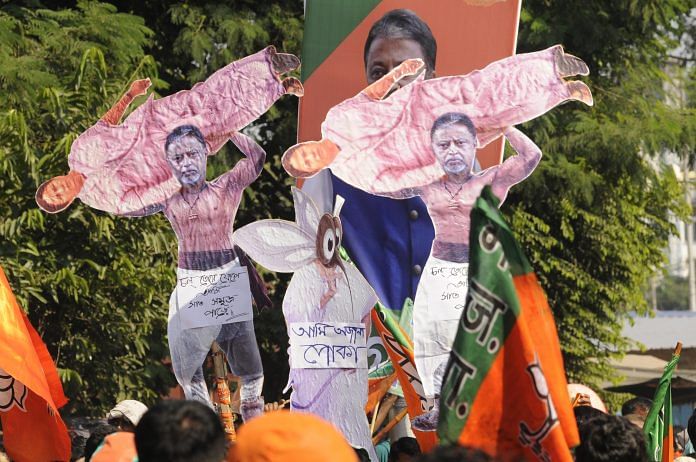The history of Bengal since 1947, however, shows that the secular-liberal identity and religious identity could be coterminous if a conducive, enabling atmosphere exists.
The BJP in West Bengal is all revved up after the electoral victory in Gujarat and Himachal Pradesh. It is now eyeing the upcoming Panchayat polls to test the ground and increase their vote share. Recent electoral history in the state shows that the party’s vote share has indeed shot up.
This may gradually turn Bengal’s political arena into a bipolar battle where the traditional secular-liberal political parties like the Congress and the CPI-M will be further pushed to the margins, and the TMC and BJP will vie for the first and second place.
Apprehending BJP’s prospective gain in popular support, the minority votes may converge in favour of the TMC. As of now, Muslims, who make up around 28 per cent of the state’s population, have already rallied round Mamata Banerjee’s party in a number of districts in south Bengal. But in districts like Murshidabad, Malda and North Dinajpur, where Muslims are a dominant force, their support is still divided between Congress, Left and TMC in that order.
During the last phase of campaign in Bengal in 2014, Narendra Modi threatened the Muslims of packing them off to Bangladesh once his party came to power. The TMC took advantage of that and spread the ‘message of Modi’ across the length and breadth of south Bengal where the last phase voting was about to be held. The result was dramatic in those areas like Nadia, North and 24 Parganas, Howrah, Hoogly and East Midnapur districts where Muslims were in a position to influence the outcome of the votes. Out of the 17 Lok Sabha seats that went to polls in the last phase the TMC won 16, and BJP one.
But many continue to argue that the BJP will be unable to surmount the hurdle put up by the great secular-liberal-democratic tradition of Bengal.
The history of Bengal since 1947, however, shows that the secular-liberal identity and religious identity could be coterminous if a conducive, enabling atmosphere exists. Though these two identities are mutually exclusive and stand at opposite poles, past experience show that they have often collapsed into each other.
In 1946-49, a large part of Bengal (both West and East) was seized with militant peasant movement led by the Communists. Jawaharlal Nehru publicly decried the violence instigated by the Communists. Sardar Patel rushed to Kolkata (then Calcutta) and stayed there for five days in early January to assess the menace. Meanwhile, on 20 December, 1949, a posse of policemen went to a village in Khulna district (East Pakistan) to arrest a Communist leader. Failing to nab him, the policemen started looting and assaulting the villagers. Two policemen were killed in violent clashes. For days, the police went on the rampage, loot and rape. As a result, some villagers fled to West Bengal.
Similar incidents took place in Rajshahi district, where tribal people resisted the attempt to arrest a Communist organiser and five of the policemen were killed there. Soon it turned into a communal riot and thousands of Hindu started fleeing for West Bengal. Riots broke out in West Bengal too, and Muslims from Murshidabad started leaving for Pakistan. At one point of time, in Calcutta’s Park Circus area, there were at least 25,000 Muslims in refugee camps.
A peasant movement led by the Communists thus fizzled out and got engulfed in communal rioting.
Significantly, in West Bengal, Muslims and Scheduled Caste peasants were together in the front lines of the food movement of 1966, Operation Barga and land reform in 1978-82, and finally in Singur and Nandigram. Yet, during communal strife, these two communities have violently attacked each other.
Communal riots in the state were particularly horrifying in 1964 Calcutta, anti-Sikh riots in 1984 and post-Babri Mosque demolition riots in 1992.
The Congress and Left leaders have both acknowledged that they have seen how even diehard party activists turn into rabid communalists if there is a conducive atmosphere. With a steady hate campaign building up in the political arena and social media on the one hand, and the resistance to reform on the other, West Bengal’s communal politics is set to get a boost.
The author is associated with the Mahanirban Calcutta Research Group



